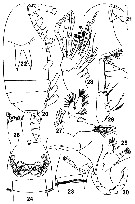|
|
 |
|
Calanoida ( Order ) |
|
|
|
Clausocalanoidea ( Superfamily ) |
|
|
|
Scolecitrichidae ( Family ) |
|
|
|
Amallothrix ( Genus ) |
|
|
| |
Amallothrix aspinosa (Roe, 1975) (F) | |
| | | | | | | Syn.: | Scolecithricella aspinosa Roe, 1975 (p.321, Descr.F, figs.F); Bradford & al., 1983 (p.103); Vyshkvartzeva, 1999 (2000) (Rem.: p.236, 237);
Ref. compl.: Vives, 1982 (p.292); Vives & Shmeleva, 2007 (p.791, figs.F, Rem.) | | | | Ref.: | | | Vyshkvartzeva, 2005 (p.162, Redescr.F, Rem.) |  issued from : H.S.J. Roe in Bull. British Mus. (Natural History) Zool., London, 1975, 28 (7). [p.322, p.13]. As Scolecithricella aspinosa. Female (Cape Verde Islands): a, habitus (dorsal); b, forehead and rostrum (left lateral side); c, last thoracic segment and urosome (right lateral side); ; d, A2; e, mandibular palp; f, Mx1; g, Mx2 (exopod); h, Mx2 (endopod); i, Mxp; j, P1; k, P2; l, P2 (exopodite segments 2-3, paratype); m, P3; n, P4; o, P4 (endopod anterior surface); p, P5. Bar scale 0.1 mm unless indicated. Nota: Cephalothorax 3.6 times as long as the 4-segmented abdomen. Head and 1st thoracic segment fused, 4th and 5th partially fused. Rostrum with 2 filaments, thick sausage-shaped bases. A1 23-segmented, reaches to the end of the caudal rami. Exopod of Mx1 with a group of spines. Endopod of Mx2 with 5 brush-like setae and 3 worm-like setae. In the holotype the worm-like setae are very wrinkled but this may be an artifact of preservation as in one of the paratypes these setae are simple flattened filaments. Basal segment of Mxp with 1 brush-like and 2 worm-like setae. No external spines on the 1st and 2nd exopodite segments of P1. Genital segment longer than the combined length of the three subsequent segments. Caudal rami about as lons as wide.
|
 Issued from N.V. Vyshkvartzeva in Zoosyst. Rossica, 2005, 13 (2). [p. 163, Figs.20-30]. Female (from 14°N, 132°30'W): 20, habitus (lateral); 21, forehead (lateral); 22, rostrum; 23,genital double-somite (right lateral); 24, same (ventral); 25, Md (palp); 26, Md (masticatory edge of gnathobase); 27, mx1; 28, Mx2; 29, Mxp; 30, P5.
|
 Issued from N.V. Vyshkvartzeva in Zoosyst. Rossica, 2005, 13 (2). [p. 164, Figs.31-36]. Female : 31, Urosome (dorsal); 32, A2; 33, P1; 34, P2; 35, P3; 36, P4; (34-36: 2 distal segments of exopod and endopod of P2-P4 detached). Nota: Females from the northeastern Pacific agree with the description of Scolecithricella aspinosa Roe, 1975 from the northeastern Atlantic, apart from the following features: - Body slightly larger; - A2 has a short seta on exopodal segment 2 and no medial seta on the terminal segment; - Basis of Md with 3 inner setae; - Syncoxa of Mxp lacks 1 seta on the 1st inner lobe (this seta is present in Roe's specimen); - Mx1 with a group of spinules on the exopod and also on the basis and endopod; - Mx2 with 3 wide, flattened worm-like setae on the endopod and 1 worm-like seta on inner lobe 5.
| | | | | Compl. Ref.: | | | Kuriyama & Nishida, 2006 (p.299: Tab.II; p.309: Tab.III, fig. 10, vertical distribution). | | | | NZ: | 3 | | |
|
Distribution map of Amallothrix aspinosa by geographical zones
|
| | | | Loc: | | | NE Atlant. (Cape Verde Is.), NE Pacif (tropical), Japan (Sagami Bay) | | | | N: | 4 | | | | Lg.: | | | (8) F: 3,65-3,19; (941) F: 3,88; (1000) F: 3,6; {F: 3,19-3,88} | | | | Rem.: | bathypelagic (depth: 1000-1250 m).
Vyshkvartzeva (2000, p.236) points out that Roe (1975) noted the closeness of this species in 6 characters to P. canariensis placed in the new genus Pseudoamallothrix, but as A. aspinosa does not have the key characters of Pseudoamallothrix (rostrum with thick filaments longer than strong proximal part; the swelling on exopodal segment 1 of A2; the notch on the external margin of P2 and P3 and projectiob on the inner margin of P2-P4), it cannot be placed in Pseudoamallothrix. The similarities noted by Roe (1975) seem to be less essential than the peculiar characteristics of the two genera. The shape of the female P5 of A. aspinosa is peculiar and do not fit ant of the 4 genera of Scolecitrichidae. In combination with some primitive and derived features of appendages, they may be used for separation of a new subgenus (or ? genus), but description of the male is necessary for final decision.
| | | Last update : 18/01/2021 | |
|
|
 Any use of this site for a publication will be mentioned with the following reference : Any use of this site for a publication will be mentioned with the following reference :
Razouls C., Desreumaux N., Kouwenberg J. and de Bovée F., 2005-2026. - Biodiversity of Marine Planktonic Copepods (morphology, geographical distribution and biological data). Sorbonne University, CNRS. Available at http://copepodes.obs-banyuls.fr/en [Accessed January 07, 2026] © copyright 2005-2026 Sorbonne University, CNRS
|
|
 |
 |






